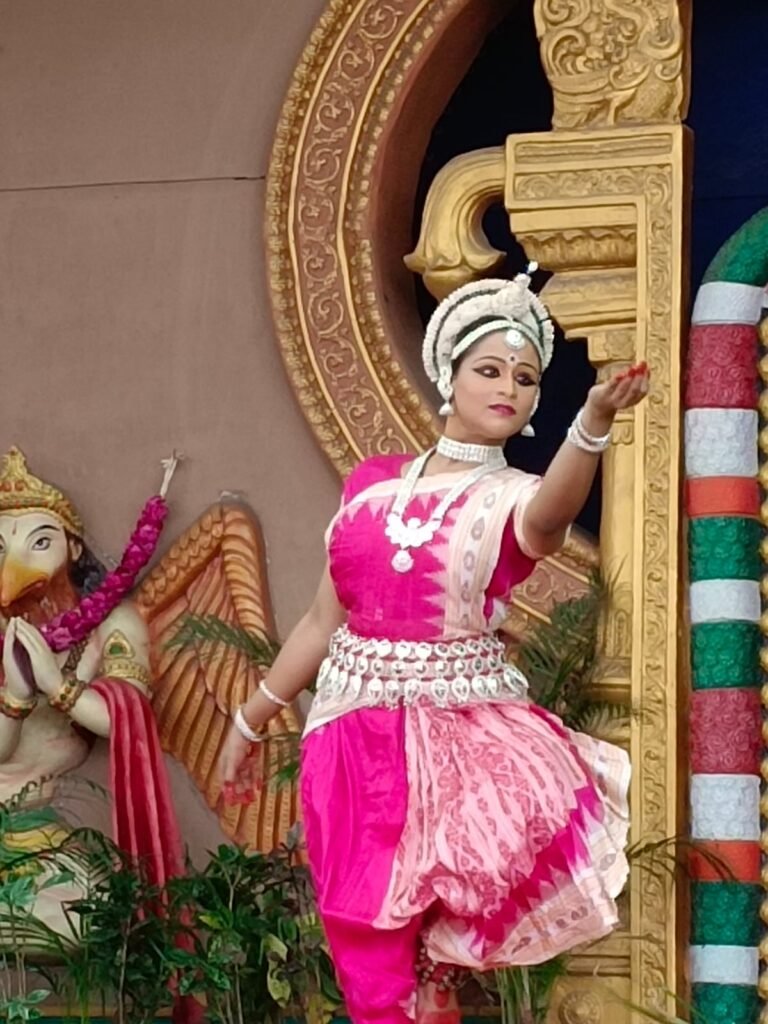The Sculptural Poetry of Eastern India
Odissi, the classical dance form of Odisha, is often described as ‘sculpture in motion’ for its sinuous grace, lyrical storytelling, and deep spiritual resonance. With roots that reach back over 2,000 years, Odissi embodies the sacred union of devotion (bhakti), music, and movement, echoing the rhythm of temple traditions and divine love.
A Sacred Origin
Odissi finds its genesis in the rituals of Odisha’s ancient temples, particularly the famous Jagannath Temple of Puri. It was originally performed by Maharis, temple dancers who dedicated their lives to worship through dance. Over centuries, Gotipuas—young boys dressed as women—also carried forward the tradition, keeping it alive through folk interpretations. With the cultural renaissance of the 20th century, led by stalwarts like Guru Kelucharan Mohapatra, Odissi was revived and codified as one of India’s eight classical dance forms.

Spiritual Aesthetics and Technical Precision
The essence of Odissi lies in its unique postures, fluid torso movements, and expressive abhinaya. Dancers often assume the tribhangi posture (dividing the body into three bends: neck, torso, and knee), which gives the form its characteristic sculptural quality. The performance begins with Mangalacharan (invocation), followed by Batu Nritya (pure dance), Pallavi (musical elaboration), Abhinaya (narrative piece), and ends with Moksha (spiritual liberation). The stories, often drawn from the Gita Govinda by poet Jayadeva, celebrate the divine love of Radha and Krishna, symbolizing the soul’s yearning for the supreme.
Costume, Music, and Ornamentation
Odissi dancers wear richly embroidered silk sarees in bright colors with traditional silver jewelry, including elaborate belts, bangles, earrings, and the iconic tahiya—a white, flower-like crown. The makeup highlights expressive eyes, and the red alta on the hands and feet enhances each gesture. The accompanying music follows the Odissi tradition, distinct from both Hindustani and Carnatic systems, and features instruments like the mardala (percussion), flute, sitar, and violin.
Modern Pathways, Ancient Roots
Though rooted in temple traditions, Odissi has expanded onto international stages and into modern narratives. Contemporary artists explore new themes—ecology, human emotion, societal issues—through the classical idiom, preserving the form’s integrity while making it relevant to today’s audiences. This harmony of continuity and innovation is what makes Odissi both timeless and ever-evolving.
At Sri Radha Krishna Kalakshetra, we view Odissi not just as a dance form but as a path to spiritual and artistic awakening. Our program offers comprehensive training in technique, theory, and performance, nurturing students to become confident performers and thoughtful practitioners. From foundational steps to complex choreography, every lesson is infused with discipline, joy, and reverence for tradition. We believe that through Odissi, students learn not just to dance, but to embody grace, resilience, and devotion.
Join us in honoring the poetic elegance of Odissi—a dance where every curve speaks, every glance tells a story, and every movement is a tribute to the divine.

Sri Radhakrishna Kalakshetra, established in 1998, is a premier institute dedicated to preserving and promoting Indian classical dance and music through disciplined training, cultural programs, and global performances.
All Rights Reserved © 2025 | Sri Radhakrishna Kalakshetra